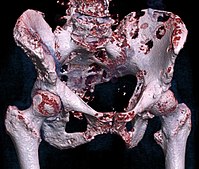
Photo from wikipedia
Background The incidence of bone metastases in non-small cell lung cancer (NSCLC) patients is about 30-40% and bone-related events can seriously affect quality of life. Immune checkpoint inhibitor (ICI) therapy… Click to show full abstract
Background The incidence of bone metastases in non-small cell lung cancer (NSCLC) patients is about 30-40% and bone-related events can seriously affect quality of life. Immune checkpoint inhibitor (ICI) therapy has become the standard treatment for advanced NSCLC patients. However, the specific efficacy of ICIs in NSCLC patients with bone metastases remains unclear. The aim of the present study was to explore the prognosis of immunotherapy in this population and to find potential biomarkers. Methods In this retrospective study, a total of 110 advanced NSCLC patients with bone metastases who received pembrolizumab therapy were enrolled. Patient characteristics; palliative bone radiotherapy or bone-targeted therapy; serum levels of lactate dehydrogenase (LDH), and the neutrophil-to-lymphocyte ratio (NLR) at baseline were assessed. The correlation of these factors with progression-free survival (PFS), overall survival (OS), and objective response rate (ORR) was analyzed. Results The ORR of the total population was 29.1%, and PFS and OS were 7.0 and 14.8 months, respectively. Fifty-eight patients (52.7%) received pembrolizumab treatment as first-line therapy, and 52 patients (47.3%) as second-line therapy or beyond [ORR: 41.4% vs. 15.4%, P=0.011; PFS: 9.0 vs. 4.0 months, P=0.004; OS: not reached (NR) vs. 11.5 months, P<0.0001]. Bone therapy, including palliative bone radiotherapy and bone-targeted therapy, increased the ORR (34.9% vs. 11.1%, P<0.0001) and prolonged PFS (8.5 vs. 2.0 months, P=0.002). Eastern Cooperative Oncology Group performance status score of 0-1 [OS: hazard ratio (HR) =0.117, P<0.0001] and first-line pembrolizumab therapy (OS: HR =0.372, P=0.004) were independent predictors of OS. Patients whose baseline serum LDH level was ≤240.5 IU/L (NR vs. 10.0 months, P<0.0001) or NLR ≤5.55 (NR vs. 18.0 months, P=0.039) showed longer OS. Conclusions The efficacy of Pembrolizumab therapy is confirmed in advanced NSCLC patients with bone metastases, particularly when palliative bone radiotherapy or bone-targeted therapy is delivered. Baseline serum LDH level ≤240.5 IU/L and NLR ≤5.55 might predict the prognosis of patients with bone metastases from advanced NSCLC treated with immunotherapy.
Journal Title: Translational lung cancer research
Year Published: 2022
Link to full text (if available)
Share on Social Media: Sign Up to like & get
recommendations!